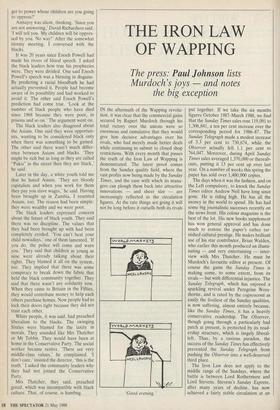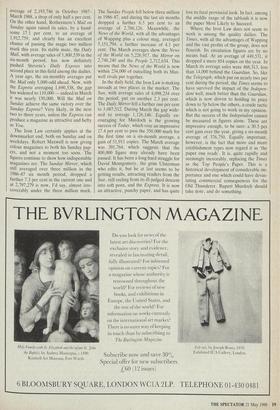THE IRON LAW OF WAPPING
Murdoch's joys — and notes the big exception
IN the aftermath of the Wapping revolu- tion, it was clear that the commercial gains secured by Rupert Murdoch through his total victory over the unions were so enormous and cumulative that they would give him decisive advantages over his rivals, who had merely made better deals while continuing to submit to closed shop restrictions. With every month that passes the truth of the Iron Law of Wapping is demonstrated. The latest proof comes from the Sunday quality field, where the vast profits now being made by the Sunday Times, and the ease with which its mana- gers can plough them back into attractive innovations — and sheer size — are increasingly reflected in the circulation figures. At the rate things are going it will not be long before it outsells both its rivals 'Good evening.' put together. If we take the six months figures October 1987–March 1988, we find that the Sunday Times sales rose 119,091 to 1,306,841, a ten per cent increase over the corresponding period for 1986-87. The Sunday Telegraph made a modest increase of 3.3 per cent to 730,674, while the Observer actually fell 1.1 per cent to 764,047. Moreover, during April Sunday Times sales averaged 1,370,000 or thereab- outs, putting it 13 per cent up over last year. On a number of weeks this spring the paper has sold over 1,400,000 copies.
The days when it was the fashion, and on the Left compulsory, to knock the Sunday Times editor Andrew Neil have long since gone. He is riding high. He has all the money in the world to spend. He has had some big journalistic successes recently on the news front. His colour magazine is the best of the lot. His new books supplement has won general approval and has done much to restore the paper's rather tar- nished cultural prestige. He makes brilliant use of his star contributor, Brian Walden, who earlier this month produced an illumi- nating — and very entertaining — inter- view with Mrs Thatcher. He must be Murdoch's favourite editor at present. Of course the gains the Sunday Times is making come, to some extent, from its rivals — but with differential injustice. The Sunday Telegraph, which has enjoyed a sparkling revival under Peregrine Wors- thorne, and is rated by the cognoscenti as easily the liveliest of the Sunday qualities, is now suffering, almost entirely because, like the Sunday Times, it has a heavily conservative readership. The Observer, though going through a particularly bad patch at present, is protected by its read- ership structure, which is largely liberal- left. Thus, by a curious paradox, the success of the Sunday Times has effectively prevented the Sunday Telegraph from pushing the Observer into a well-deserved third place.
The Iron Law does not apply to the middle range of the Sundays, where the battle is between Lord Rothermere and Lord Stevens. Stevens's Sunday Express, after many years of decline, has now achieved a fairly stable circulation at an average of 2,193,746 in October 1987– March 1988, a drop of only half a per cent. On the other hand, Rothermere's Mail on Sunday again raised its sales, by a hand- some 17.1 per cent, to an average of 1,912,759, and clearly has an excellent chance of passing the magic two million mark this year. Its stable mate, the Daily Mail, with average sales of 1,800,539 in the six-month period, has now definitely pushed Stevens's Daily Express into second place in this field among the dailies. A year ago, the six-monthly averages put the Mail only 5,000-odd ahead. Now, with the Express averaging 1,690,538, the gap has widened to 110,000 — indeed in March it was nearly 150,000. Will the Mail on Sunday achieve the same victory over the Sunday Express? Very likely, in the next two to three years, unless the Express can produce a magazine as attractive and hefty as You.
The Iron Law certainly applies at the downtnarket end, both on Sunday and on weekdays. Robert Maxwell is now giving colour magazines to both his Sunday pap- ers, and not a moment too soon. The figures continue to show how indispensible magazines are. The Sunday Mirror, which still averaged over three million in the 1986-87 six month period, dropped a further 7.3 per cent in the current one and at 2,797,279 is now, I'd say, almost irre- coverably under the three million mark. The Sunday People fell below three million in 1986-87, and during the last six months dropped a further 6.5 per cent to an average of 2,766,126. Meanwhile, the News of the World, with all the advantages of Wapping plus a colour mag, averaged 5,151,794, a further increase of 4.1 per cent. The March averages show the NeWs of the World on 5,226,917, the Mirror on 2,748,240 and the People 2,712,634. This means that the News of the World is now within 234,000 of outselling both its Max- well rivals put together.
In the daily field, the Iron Law is making inroads at two places in the market. The Sun, with average sales of 4,098,234 over the period, put on another 2.3 per cent. The Daily Mirror fell a further one per cent to 3,087,512. During March the gap wide- ned to average 1,126,146. Equally en- couraging for Murdoch is the growing success of Today, which rose an impressive 17.4 per cent to pass the 350,000 mark for the first time on a six-month average, a gain of 51,911 copies. The March average was 391,764, which suggests that the 400,000 figure may already have been passed. It has been a long hard struggle for David Montgomery, the grim Ulsterman who edits it, but he at last seems to be getting results, attracting readers from the Star, still reeling from its ill-judged descent into soft porn, and the Express. It is now an attractive, punchy paper, and has quite lost its fatal provincial look. In fact, among the middle range of the tabloids it is now the paper Most Likely to Succeed.
Where. the Iron Law does not seem to work is among the quality dailies. The Times, with all the advantages of Wapping and the vast profits of the group, does not flourish. Its circulation figures are by no means bad. At an average of 449,531, it dropped a mere 854 copies on the year. In March its average sales were 468,313, less than 14,000 behind the Guardian. So, like the Telegraph, which put on nearly two per cent during the period, the Times seems to have survived the impact of the Indepen- dent well; much better than the Guardian, which is now driven to holding its price down to 5p below the others, a crude tactic which is not going to work in my opinion. But the success of the Independent cannot be measured in figures alone. These are impressive enough, to be sure: a 30.5 per cent gain over the year, giving a six-month average of 376,750. Equally important, however, is the fact that more and more establishment types now regard it as 'the paper one reads'. It is, quite rapidly and seemingly inexorably, replacing the Times as the Top People's Paper. This is a historical development of considerable im- portance and one which could have devas- tating commercial consequences for the Old Thunderer. Rupert Murdoch should take note, and do something.































































 Previous page
Previous page